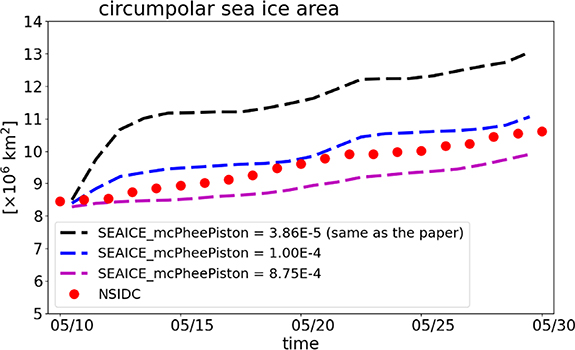Export citation and abstract BibTeX RIS
In our article and its supplemental material, we examined the causes for a systematic model overestimation of the Antarctic sea-ice edge. We concluded that this overestimation was not due to uncertainties in the sea ice or ocean models, but due to an underestimate of downwelling longwave radiation (DLW). We performed an extensive sensitivity analysis, testing various aspects of the simulation, such as the sea ice dynamics solver, the sea ice lead closing parameter h0, the ocean vertical diffusion coefficients, and different ocean initial conditions. However, all simulations overestimated the predicted sea-ice growth during the sea-ice growth period.
Since publication, however, we have found an important source of uncertainty in the sea ice model related to parameterized heat exchanges between ice and ocean (Maykut and McPhee 1995, Holland and Jenkins 1999, Kim et al 2006, Hunke et al 2017). In our Massachusetts Institute of Technology (MIT) general ocean circulation model (MITgcm) simulations presented in the manuscript, we used the parameters to simulate sea ice from Version 4 Release 4 of ECCO (Estimating the Circulation and Climate of the Ocean) global ocean and sea ice model (Forget et al 2015, ECCO Consortium 2020). In this implementation, sea ice can form before the ocean temperature in the top ocean model grid cell reaches the freezing point due to a parameterized limitation in the rate of available heat transfer from the ocean (Fenty 2010). Limiting the heat transfer rate from the ocean to ice is a common assumption. The heat exchange rate is determined by a constant times a friction velocity times the temperature above the freezing point (equation (5.29) in McPhee 2017). This limitation is often not considered until the ice has formed; however, the MITgcm always considers this limited heat availability. This is justified as the temperature of the upper grid cell represents a bulk heat content, and not the true 'Sea Surface Temperature'. We can increase the ocean heat availability preventing sea ice formation until the upper ocean cell is at the freezing temperature by increasing a constant in the model referred to as 'SEAICE_mcPheePiston'. In doing so the sea ice growth rate can be reduced compared to the results shown in our article (figure 1).
Figure 1. The circumpolar sea ice area obtained in the simulations using different values for SEAICE_mcPheePiston (see text for explanation). The coefficient value used in the manuscript is shown as the black dashed line.
Download figure:
Standard image High-resolution imageBecause available heat flux from the upper ocean model grid cell is limited in the case presented in the paper, sea ice will grow where this cell temperature is warmer than the freezing point. Sea ice growth can be slowed down by changing this parameterization and requiring that the upper grid cell fully reaches the freezing temperature in order for sea ice to form (figure 1). Figure 2 shows the sea ice extent and upper grid cell temperatures for three cases of different heat transfer rate on 31 May 2018. Figure 2 also shows these quantities in the European Centre for Medium-Range Weather Forecasts (ECMWF) forecast, providing evidence that upper ocean model temperature can be above freezing when ice forms in that system as well. Since the forecasts are modeling the bulk temperature in the upper grid cell, further work is needed to determine which solutions are a better representation of the actual oceanic conditions and to determine the uncertainty in handling this parameterization. This conclusion will depend on the observed temperature scales of variability.
Figure 2. Snapshot of the upper ocean model grid cell temperature and sea ice area obtained in the simulation and those in the ECMWF S2S dataset on 31 May 2018. The black contours in panels (a)–(d) denote the sea ice extent defined by a 15% sea ice fraction. The solid lines indicate the sea ice extent on 31 May; the dashed lines indicate the model initialized sea ice extent on 10 May.
Download figure:
Standard image High-resolution imageThe evidence in the article remains valid, showing that the ECMWF reanalysis 5th generation and other reanalyses underestimate DLW during the sea ice growth period in the Antarctic region. Comparison to observations implied large uncertainties in the reanalysis DLW radiation. We found a deficit of approximately 20 W m−2 when compared to the Ocean Observatories Initiative mooring data in the South Pacific at 54.08° S, 89.67° W. We also were not able to simulate sea ice growth consistent with observations without enhancing DLW. However, in this addendum, we now add the significant caveat that the sea-ice model is also very sensitive to the parameterization of available heat content from the ocean. Although the uncertainty of the DLW radiation is still a major concern, we also now highlight the need for a better understanding of the sea ice-ocean energy budget in the marginal ice zone throughout the sea ice growing season. A dedicated effort could yield the necessary data to identify the cause of these model biases and improve Antarctic sea ice predictability.




